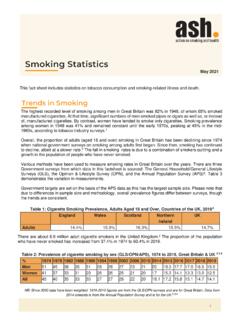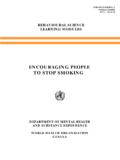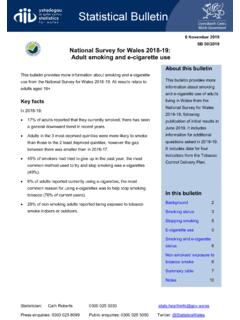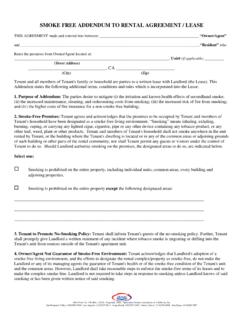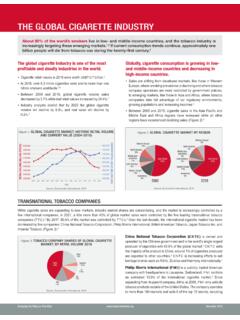Transcription of Cigarette Smoking and Lung Cancer
1 Centers for Disease Control and Prevention Epidemiology Program Office Case Studies in Applied Epidemiology No. 731-703 Cigarette Smoking and Lung Cancer Student's Guide Learning Objectives After completing this case study, the participant should be able to: G Discuss the elements of study design, and the advantages and disadvantages of case-control versus prospective cohort studies; G Discuss some of the biases that might have affected these studies; G Calculate a rate ratio, rate difference, odds ratio, and attributable risk percent; G Interpret each measure and describe each measure's main use; and G Review the criteria for causation.
2 This case study is based on the classic studies by Doll and Hill that demonstrated a relationship between Smoking and lung Cancer . Two case studies were developed by Clark Heath, Godfrey Oakley, David Erickson, and Howard Ory in 1973. The two case studies were combined into one and substantially revised and updated by Nancy Binkin and Richard Dicker in 1990. Current version updated by Richard Dicker with input from Julie Magri and the 2003 EIS Summer Course instructors. DEPARTMENT OF HEALTH AND HUMAN SERVICES Public Health Service CDC / EIS Summer Course 2003: Smoking and Lung Ca - Student's Guide Page 2 A causal relationship between Cigarette Smoking and lung Cancer was first suspected in the 1920s on the basis of clinical observations.
3 To test this apparent association, numerous epidemiologic studies were undertaken between 1930 and 1960. Two studies were conducted by Richard Doll and Austin Bradford Hill in Great Britain. The first was a case-control study begun in 1947 comparing the Smoking habits of lung Cancer patients with the Smoking habits of other patients. The second was a cohort study begun in 1951 recording causes of death among British physicians in relation to Smoking habits. This case study deals first with the case-control study, then with the cohort study. Data for the case-control study were obtained from hospitalized patients in London and vicinity over a 4-year period (April 1948 - February 1952).
4 Initially, 20 hospitals, and later more, were asked to notify the investigators of all patients admitted with a new diagnosis of lung Cancer . These patients were then interviewed concerning Smoking habits, as were controls selected from patients with other disorders (primarily non-malignant) who were hospitalized in the same hospitals at the same time. Data for the cohort study were obtained from the population of all physicians listed in the British Medical Register who resided in England and Wales as of October 1951. Information about present and past Smoking habits was obtained by questionnaire. Information about lung Cancer came from death certificates and other mortality data recorded during ensuing years.
5 Question 1: What makes the first study a case-control study? Question 2: What makes the second study a cohort study? The remainder of Part I deals with the case-control study. Question 3: Why might hospitals have been chosen as the setting for this study? CDC / EIS Summer Course 2003: Smoking and Lung Ca - Student's Guide Page 3 Question 4: What other sources of cases and controls might have been used? Question 5: What are the advantages of selecting controls from the same hospitals as cases? Question 6: How representative of all persons with lung Cancer are hospitalized patients with lung Cancer ? Question 7: How representative of the general population without lung Cancer are hospitalized patients without lung Cancer ?
6 Question 8: How may these representativeness issues affect interpretation of the study's results? CDC / EIS Summer Course 2003: Smoking and Lung Ca - Student's Guide Page 4 Over 1,700 patients with lung Cancer , all under diagnosis proved mistaken. The final study age 75, were eligible for the case-control study. group included 1,465 cases (1,357 males and About 15% of these persons were not 108 females). interviewed because of death, discharge, severity of illness, or inability to speak English. The following table shows the relationship An additional group of patients were interviewed between Cigarette Smoking and lung Cancer but later excluded when initial lung Cancer among male cases and controls.
7 Table 1. Smoking status before onset of the present illness, lung Cancer cases and matched controls with other diseases, Great Britain, 1948-1952. Cases Controls Cigarette smoker Non-smoker 1,350 1,296 7 61 Total 1,357 1,357 Question 9: From this table, calculate the proportion of cases and controls who smoked. Proportion smoked, cases: Proportion smoked, controls: Question 10: What do you infer from these proportions? Question 11a: Calculate the odds of Smoking among the cases. Question 11b: Calculate the odds of Smoking among the controls. Question 12: Calculate the ratio of these odds. How does this compare with the cross-product ratio?
8 CDC / EIS Summer Course 2003: Smoking and Lung Ca - Student's Guide Page 5 Question 13: What do you infer from the odds ratio about the relationship between Smoking and lung Cancer ? Table 2 shows the frequency distribution of male cases and controls by average number of cigarettes smoked per day. Table 2. Most recent amount of cigarettes smoked daily before onset of the present illness, lung Cancer cases and matched controls with other diseases, Great Britain, 1948-1952. Daily number of cigarettes # Cases # Controls Odds Ratio 0 7 61 referent 1-14 565 706 15-24 445 408 25+ 340 182 All smokers 1,350 1,296 Total 1,357 1,357 Question 14: Compute the odds ratio by category of daily Cigarette consumption, comparing each Smoking category to nonsmokers.
9 Question 15: Interpret these results. CDC / EIS Summer Course 2003: Smoking and Lung Ca - Student's Guide Page 6 Although the study demonstrates a clear cause-and-effect is not the only explanation. association between Smoking and lung Cancer , Question 16: What are the other possible explanations for the apparent association? The next section of this case study deals with the cohort study. Data for the cohort study were obtained from the population of all physicians listed in the British Medical Register who resided in England and Wales as of October 1951. Questionnaires were mailed in October 1951, to 59,600 physicians. The questionnaire asked the physicians to classify themselves into one of three categories: 1) current smoker, 2) ex-smoker, or 3) nonsmoker.
10 Smokers and ex-smokers were asked the amount they smoked, their method of Smoking , the age they started to smoke, and, if they had stopped Smoking , how long it had been since they last smoked. Nonsmokers were defined as persons who had never consistently smoked as much as one Cigarette a day for as long as one year. Usable responses to the questionnaire were received from 40,637 (68%) physicians, of whom 34,445 were males and 6,192 were females. Question 17: How might the response rate of 68% affect the study's results? CDC / EIS Summer Course 2003: Smoking and Lung Ca - Student's Guide Page 7 The next section of this case study is limited to the analysis of male physician respondents, 35 years of age or older.










